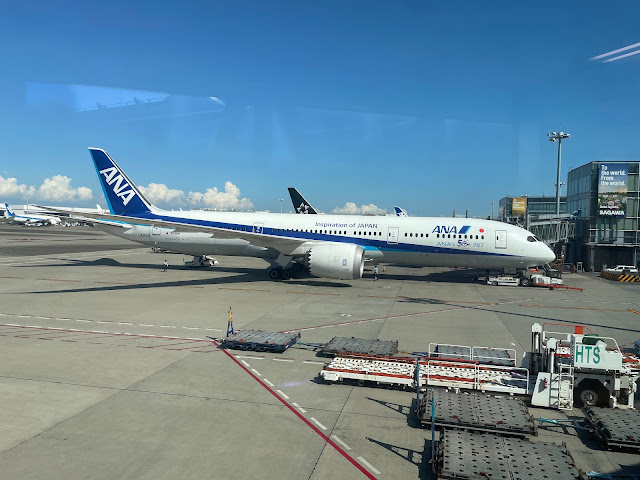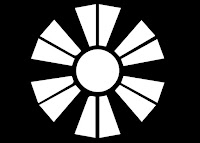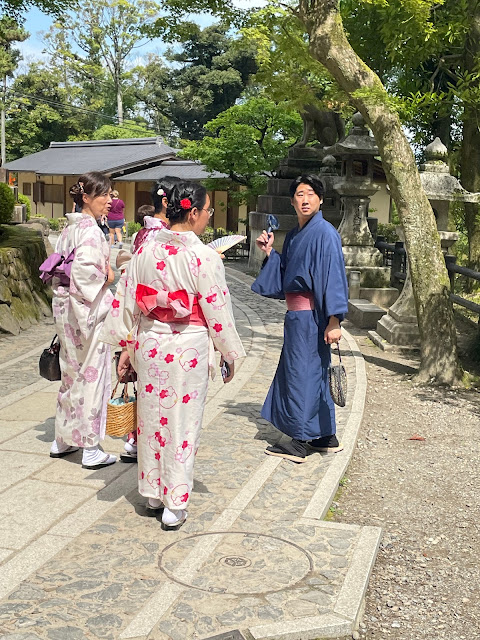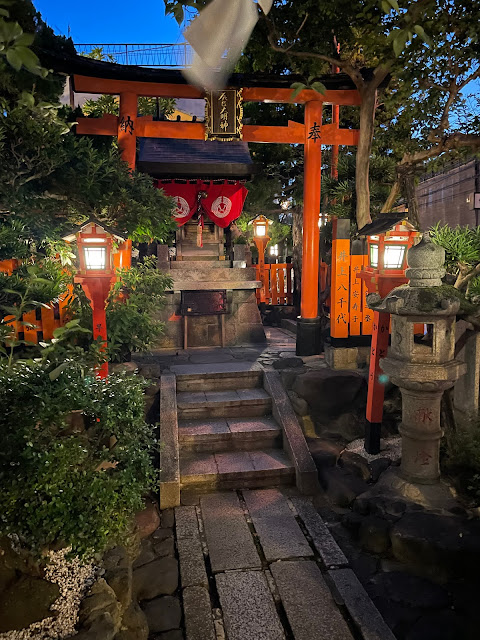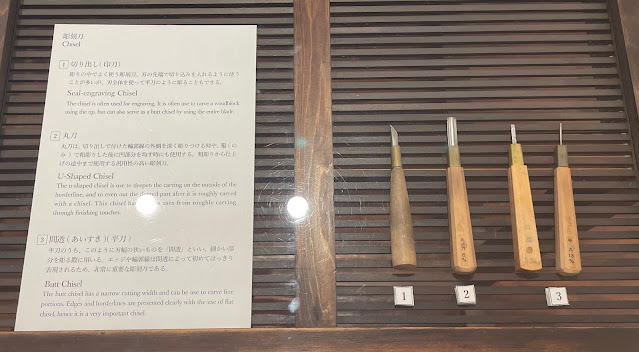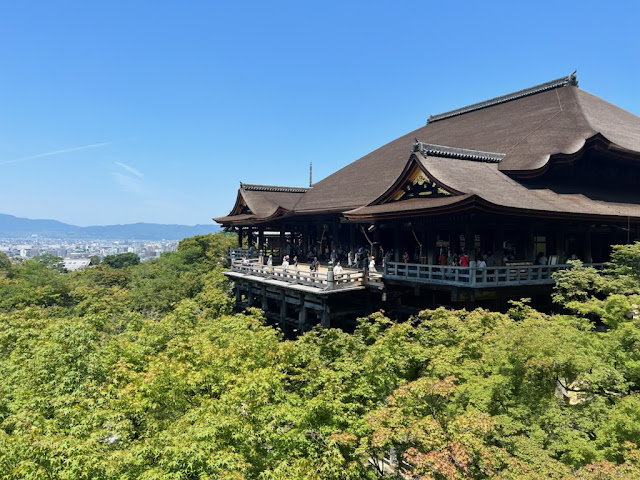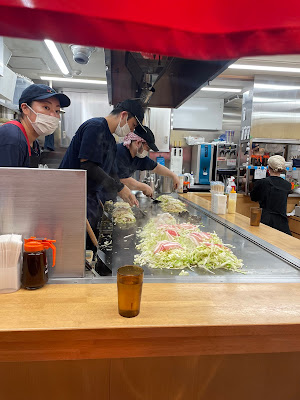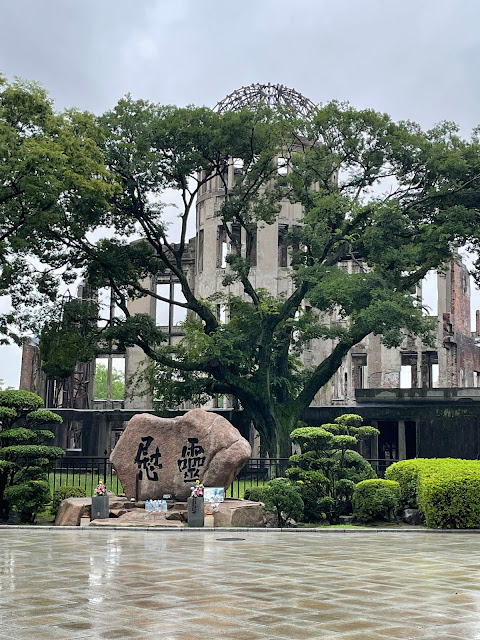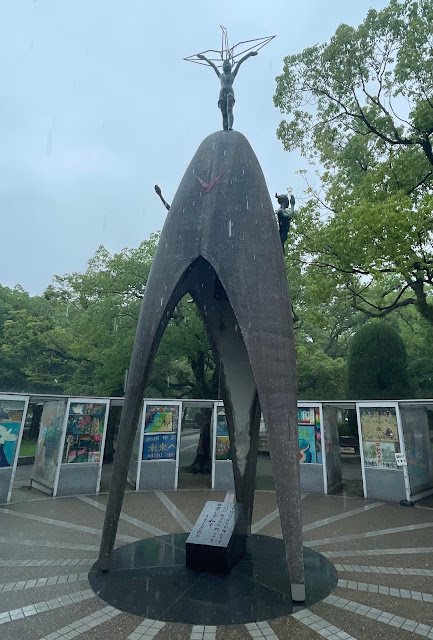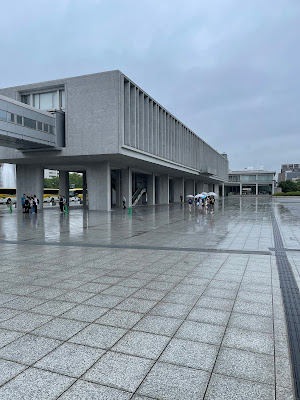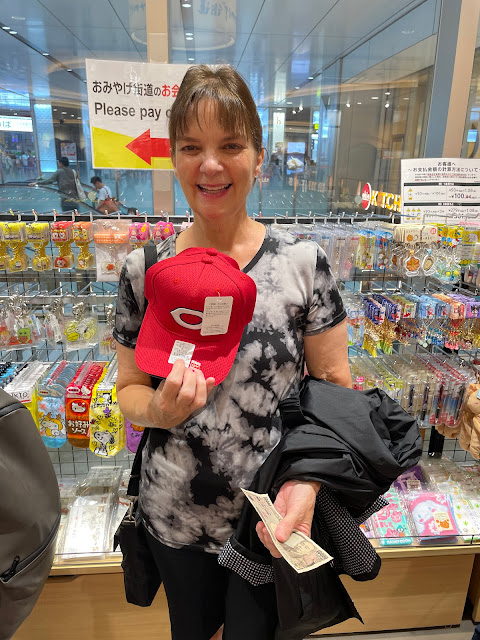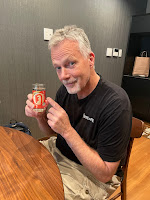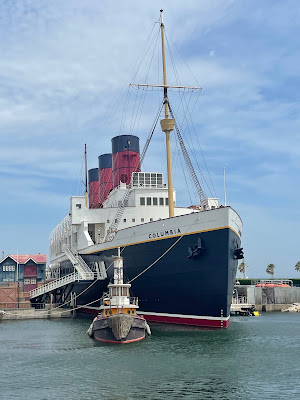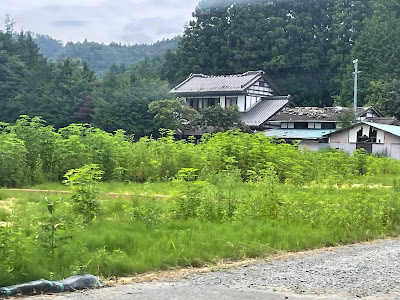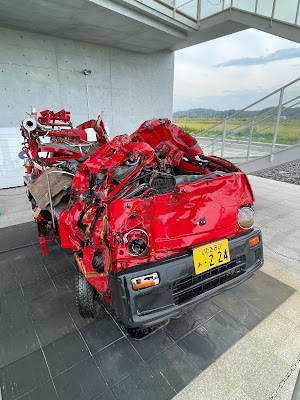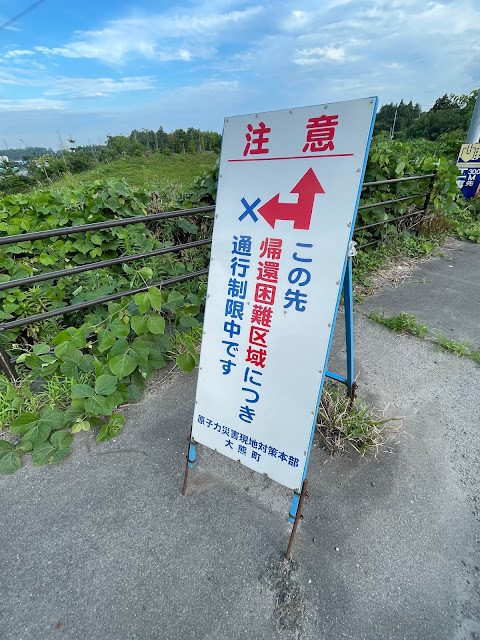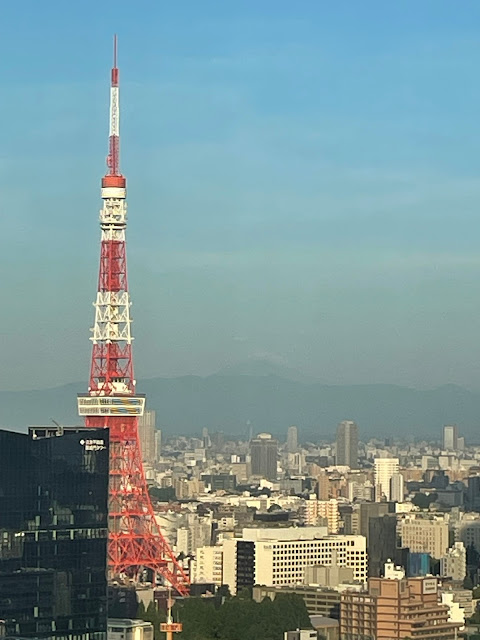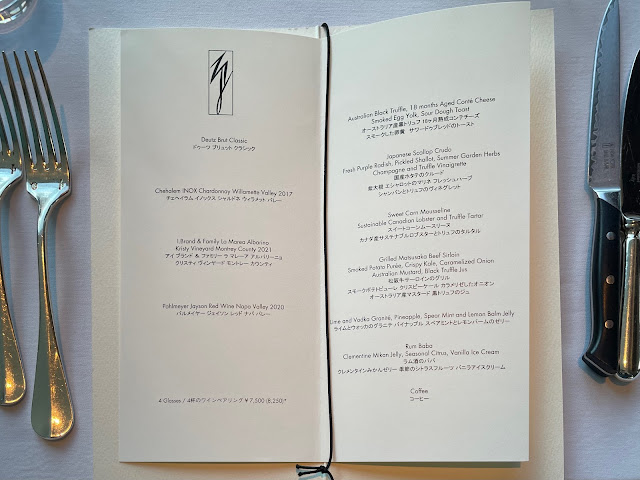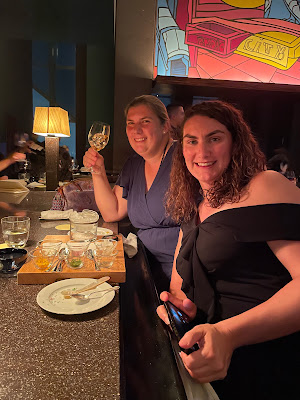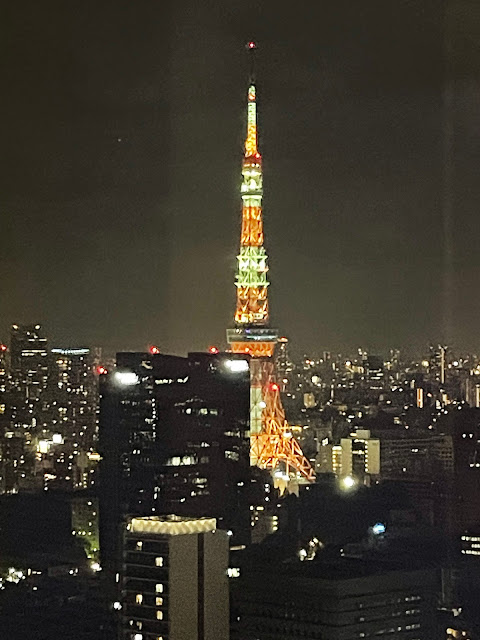 |
| Fushimi-Inari Taisha (Kyoto, Japan) |
This adventure had been twelve years in the making. Tom and Laura had spent months planning a once-in-a-lifetime spring break trip to Japan, but those intentions were dashed on March 11, 2011. We were literally hours from boarding our flight when the news of a megathrust earthquake and subsequent tsunami stunned the world. It was the most powerful earthquake in Japan’s history. The country was devastated and Laura’s dream experience was put on indefinite hold.
U.S. State Department Announcement - March 12, 2011
A decade later, Laura and her husband, Alex, chose a honeymoon in Japan as their wedding gift, but it would have to wait until the end of a worldwide pandemic. Finally, in the summer of 2023, twelve years after our initial plans, Laura’s long-awaited journey to Japan was about to come true.
The trip would become a family affair when Tom and Tam decided to come along to pick up the tab, and Michelle and Hailee served as travel guides. The more, the merrier!
Friday, June 31, 2023
Getting Ready
Sarasota
Tampa International Airport
After a year of preparation, learning customs and language, and waiting for Covid restrictions to lift, we were ready to fly halfway around the world.
How To Translate A Japanese Washing Machine
Japan is an island nation in more ways than one. Historically, it has been insular for centuries through the implementation of sakoku, and didn’t open up to world trade until almost 1900. Only nine percent of the populace speak English (according to a survey of English proficiency in 112 non-English speaking countries and regions, Japan was ranked at 80th place).
And also at the close of the Covid pandemic, Japan was the last country to open up to outsiders (fortunately six weeks before our trip, making all testing and vaccine documentation unnecessary). Yet even as late as June 19th, more than 80 percent of Japan was still masking.
Japan To End Covid Border Measures
Japan also had the most stringent pharmaceutical restrictions of any country we’ve visited, requiring written scripts from our doctors for all the medications we were bringing in.
Even with globalization, Japan is still like a cultural iceberg, with ninety percent hidden beneath the surface. Trying to understand the tangle of social mores and customs was making us self-conscious before we even got there; no blowing your nose in public, no pointing with your finger, no shaking hands, no tipping, no tattoos, no logos on clothing, no bare feet, no gum chewing, no perfume in restaurants, no soy sauce on rice, no rubbing chopsticks together, no eating while walking, no talking or cellphones on trains, never open or close a taxi door, never be late, never serve your own drink, and never be opinionated.
In my opinion, these must be the most mannered people on earth!!
Well, not always. We also paradoxically learned that sexual groping on crowded Japanese trains and other public areas had evolved into a high art form. There was even a name for it … Chikan. Misogynistic behavior runs deep throughout Japan's history, and apparently vestiges of it still exist today.
We spent more time and effort worrying about creating a potential cultural faux-pax than for any other destination in the world. Even with the simple booking of baseball seats, we trepidatiously considered everything, starting with seat width.
In the process, we learned of a versatile Japanese aphorism, “sumimasen.” It is a universal term, meaning “excuse me, pardon me, I’m sorry, or even can you assist me?” Pronounced with an almost-silent “U” (along with a reverential bow), we practiced that word hundreds of times. It would definitely come in handy.
SUMIMASEN: The Most Versatile Word In The Japanese Language
With our flight leaving early the next morning from Tampa, we gathered at the airport Marriott. Michelle handed out official copies of the ‘football’ (complete itineraries with all confirmations, seat numbers, phone numbers, addresses, and reservations) so we would all be on the same page.
The team was together and ready to share the twelve-day expedition to the land of the rising sun.
Saturday, July 1, 2023
United Airlines Flight To Houston
All Nippon Airways Flight To Japan
The email alert hit my phone at 3:25 am. Our flight to Houston would be delayed at least two hours, making our connection uncomfortably tight. A disagreement between United and the FAA was causing massive nationwide delays and cancelations. With the help of an agent, she secured a flight to Tokyo for us the next day out of Chicago (just in case). We all checked our luggage, went back to the hotel and tried to sleep and extra hour or so.
Our United flight (UA 2293) left at 9:10 am and landed at IAH at 10:17.
We hustled to our gate (D11) where our ANA 787 was waiting for us. The agents were all speaking Japanese and ninety percent of the passengers were Japanese. It was the quietest waiting area we’d ever seen. We were the loudest, arguing over who got the Twizzlers.
Virtually nobody was masking!!
Before announcing boarding, all of the agents stood in a line and bowed to us. Tam quietly whispered, “We’re not in Kansas anymore.” Indeed we weren’t, a male agent bowed and said, “Ohio gazyamas” as he took my ticket. As we settled into our seats, I inadvertently found some trash in the seat pocket and handed it to a flight attendant, with my first “sumimasen.” She got on one knee, bowed her head, and apologized profusely. The look on her face was total shame. I thought to myself, “Oh crap! I’ll never do that again!” And she bowed again with the arrival of the beverage cart. Then another FA bowed to us as she closed the first class curtain in front of us. It was mesmerizing to watch the ritual, but I still felt a bit awkward. The level of self-consciousness of the crew was palpable.
Nevertheless, we were so glad to be on board; no need for alternate plans. We were wheels up at 11:49 and soon cruising at 34,000 feet. Our Arctic Circle route would take us over Seattle and the Aleutian Islands, before paralleling the Kamchatka Peninsula and dropping into Tokyo.
The lunch service was excellent! Tempura shrimp, salmon nigiri, and dipping ramen noodles. Then came the Haggen-Dazs. Tam and I both concurred, it was better than most first-class meals we’d had. And the green tea was incredible!
We crossed the International Date Line over the Diomede Islands in the Bering Sea. At the moment we crossed, we moved into Sunday, but due to time zone anomalies, there was a bizarre twenty-one hour difference between Liitle Diomede Island (U.S.) and Big Diomede Island (Russia). Even though the islands are only 1.8 miles apart, we went from 3:57 pm Saturday to 12:57 Sunday.
Out of the blue, my good friend, AA787 pilot Craig Czajka, texted me during the flight. We chatted about the aircraft, and he reminded me that the wing deflection at the tips at cruise was 19.5 feet. From our tinted window, we could clearly see the wing bending upward, while revealing a Japanese rising sun.
Sunday, July 2, 2023
All Nippon Airways Flight To Japan
JR Train To Tokyo
Kyotofish-Matsuya Pine Garden Riverside Machiya
Our approach paralleled the Russian Kamchatka peninsula and Japan’s northern island, Hokkaido. We swept in from the east and then made a low pass, circling over Tokyo before landing on runway 16R.
In an auspicious sign of good fortune, the usually coy Mt. Fuji was peaking above the clouds to our south as we landed.
Haneda Airport, located about eight miles from Tokyo Station, was first opened in 1931. It was used mostly for inter-island travel during the 30s and early 40s, but shifted entirely to military use during World War II. Between 1945 and 1952, it was U.S. controlled Haneda Army Air Base, and used frequently by General Douglas MacArthur during the occupation of Japan. It was expanded extensively by our military during the Korean War. In 1958 the property was returned to the Japanese government and used as Tokyo’s primary airport, handling mostly domestic flights.
In preparation for the 2020 Summer Olympics, Haneda was opened up for international service in 2014, with new terminals completed in 2018. Although the Japanese government has encouraged premium business routes to fly into Haneda and low-cost airlines to use Narita, most airlines now use both airports. Haneda is now the fourth busiest airport in the world (behind Atlanta, Beijing, and Dubai).
Our flight landed at 3:10 pm and taxied to Terminal 3. We were nonchalantly waved through immigration and our bags made it through quickly.
We marched right through customs. They basically waved us through there, and we proceeded downstairs to the train terminals. Michelle had observed a huge line with more than a hour wait for the Shinkansen shuttle, so she changed gears and we took the subway from Haneda to Shinegawa, and from there caught the same bullet train. She saved us more than an hour.
Tam and I were about to test a new luggage configuration (very small rolling suit case and medium-sized Solgaard travel backpack for each of us). The Japanese train services were employing new regulations limiting overhead bag sizes to 21 inches in length and no more than 160 cm square. Anything larger than this would be considered ‘oversized baggage’ requiring reservations, a special space, and an additional bag fee.
JR Central Japan Railway Company
We had never traveled this light for a trip of this length before. We spent weeks packing our stuff in our tiny luggage like a three-dimensional Tetris puzzle; buying the lightest and thinest clothing, squeezing the air out of everything, and planning to dispose of many items along the way.
Our luggage was fine, by the way. There was plenty of room in the overhead of our Green (First Class) train car.
Travel throughout Japan is predominantly by rail. The Japan Railways Group (JR) is by far the largest of seventeen private rail companies that serve Japan. The ‘JR’ lines are commuter lines that link Tokyo with nearby metropolitan areas. The Skinkansen high-speed (bullet train) lines are also owned by JR and service primarily the periphery of Japan, including the outer islands of Hokkaido and Kyushu.
Even though Michelle had purchased JR rail passes for us in advance, we had to activate them using machines at the station. Once activated, our passes were good for seven days. At 5:10 pm, we jumped on board JR train Hikari for our ultimate destination, Kyoto.
The ride was super smooth and comfortable, although I thought the glass door on the men’s restroom was a little interesting.
Our bullet train journey would take us as close to Mount Fuji as we would get on our trip. On my first three visits to Japan, I never saw it. It was constantly shrouded in marine layer and pollution. In fact, Mt. Fuji can only be seen 79 days a year. Was this the big moment? It looked promising on this cloudless day. We caught our first glimpse, rising barely above the rolling foothills
We approached our nearest point at Shin-Fuji Station (27.9 miles away) and looked north. There she was, the entire mountain, with no snow cap. Fuji-san has been dormant since 1707, but seismologists believe she will reawaken in the near future.
After traveling 7,418 miles around the world (two flights and two trains), we trudged the final few blocks along Nishi-Kiyamachi-dori, a quiet side street, looking for our Air BnB address … and we found it!! Our home for the next four nights would be Kyotofish-Matsuya Pine Garden Riverside Machiya; Located at 171 Shoshinjicho, Shimogyo-ku, Kyoto, Japan. It was a traditional Japanese townhouse, located in the old part of Kyoto, along the petite Takasegawa Stream and across and slightly downstream the Kamogawa from the celebrated Gion district.
The discreet urban structure was two-stories and comprised of four tatami-mat floor bedrooms with sliding shoji screen partitions, a traditional tea room on each floor, four updated bathrooms and efficiency kitchen. An open courtyard featuring sculptural banzai pine trees, moss, stone, and sand bisected the house and provided natural light throughout the interior. It was perfect!!
Kyotofish-Matsuya Pine Garden Riverside Machiya (Air BnB)
However, it was baking hot inside. It took us an hour to find all six Mitsubishi room A/C units and their remote controls. A panel in the kitchen controlled “instant on” hot water. We got it figured out just in time to take our first showers in thirty hours.
The next step was sorting out who was sleeping where. There were several snorers in our group, and despite having a large supply of Breathe-Rite Strips and ear plugs, room selection was a delicate and strategic maneuver. Tam and I had already done our homework and selected a bedroom upstairs, mainly because it was the only one with mattresses. All of the other bedrooms were futons on mat floors. Michelle grabbed a mattress and dragged it through the house to her bedroom. We had to bend it to make it fit through the incredibly narrow hallways.
By ten, we were all tucked away and zonked out.
Monday, July 3, 2023
Fushimi-Inari-taisha
Nishiki Market
Gion District
In Japanese, the term for Japan is Nippon, which literally translates into “sun’s origin.” In Japanese culture, its meaning is powerfully auspicious. It is the first nation in the Pacific to witness the sun’s rise, spawning a popular belief that it manifests a divine destiny. This has been true throughout the nation's history, and is still conspicuous today in the design of their national flag, the Nisshoki (Flag of the Rising Sun).
Ryuzoji Clan (1185-1607)
Kyokutjitsu-ki (1603-1999)
Nisshoki (Since August 13, 1999)
Wide awake with jet-lag as the sun rose over Kyoto, we staggered around the kitchen, looking for leftovers from our raid on 7-Eleven the previous night. Laura and Alex made a morning run and picked up Melon Pan bread, chocolate chip croissants, Matto (fermented soybeans), and Tamagoyaki (egg omelet).
We chatted at the kitchen table while observing Kyoto waking up through our shoji screen windows.
While the others were getting ready, I took a seat in the courtyard/ meditation room and watched a sliver of sun move through the garden, passing through the trees and reflecting off the dark siding. A wonderful moment of repose before our busy day.
By 8 am, we were all up and ready to go!! But first, we had to make a quick stop at the local coffee shop. Kawama was located about one hundred yards north of the townhouse.
We took the local Keihan Railway from Kiyomizu-Gojo Station, approximately three miles south to Fushimi-Inari Station.
For me, the Fushimi-inari shrine would be one of the major highlights of the trip. Throughout Japan, there are thirty thousand Shinto Inari shrines, and they are all affiliated with this one. The Fushimi Inari Taisha was first established in 711 AD (predating Buddhism), as a place for residents to pray for bountiful harvests, business prosperity, the safety of their home and family and the fulfillment of wishes of all kinds.
The term ‘Inari’ means ‘reaping of rice,’ the main food source of Japan. But it also symbolizes the miracles of heaven and earth, created by a deity who feeds, clothes, and houses the people. It protects them so that they may live happily and with abundance.
Today, just as they have for a millennium, the faithful come here to pray to Inari for protection and a good life. Inari were personified as white ‘ghost’ foxes, the messengers of good things. The shrines were painted vermillion red as an amulet against evil forces and as a color that expressed bountiful harvests. The pigment continues to be made with red earth and mercury, as it had for centuries.
The build-up was gradual as we walked from Keihan Railway Fushimi-Imari Station up through a small chome. Large torii gates directed us toward the main entrance, featuring a collection of several shrines of varying size and importance.
Within the main structure were five distinct shrines represented as pillars in the building. They were named for the great virtues of Inari Okami that they embodied.
It was the perfect tourist blend of spirituality and capitalism; donate to the shrine before prayer, shake the omakuji and get a fortune for 200 yen, have your kid make a ghost fox plaque for 300 yen, buy a lucky medallion for 800 yen.
Behind the primary shrines were inclined paved trails that climbed Inariyama, and they were lined with thousands of torii gates acknowledging the passing of prayers from the people to their deity. There were more than 10,000 torii gateways along the mountain paths. These were surrounded by sacred cedar trees, symbolic of the Inari faith. Randomly spread along the paths were ‘otsuka’ stones, rocks engraved and left as offerings to the holy mountain.
The overall effect of the bright red climbing gates was stupefying. No wonder it is considered one of the most beautiful and spiritual sights in the world.
The crowds were huge, even on this 95 degree morning, and everybody was jockeying for the perfect picture. Still, the scenic beauty was off the charts. It was worth every drop of sweat.
As with so many holy sites in Japan, there were strict rules regarding loud or distracting behavior. But with the six of us huffing, puffing, and dripping as we climbed the sacred mountain. Sumimasen.
The Fushimi-inari Taisha is one of the Twenty-Two Shinto Shrines listed as most important by the Imperial Court during the Heian Period. The shrine is in the top group of Upper Seven considered the most significant. Eleven other shrines on that list are located in Kyoto.
We caught the return train back to Gion-Shinju Station, where a few blocks away was Nishiki Market. As we walked along the Kamogawa River, we stumbled across this fascinating monument.
In 1603, Izumo no Okuni performed the first Kabuke Dance along the Shijo Gawara, a dry riverbed at this location along the Kamogawa River at Gion.
Nisei Ichiba literally means ‘brocade market.’ The Nishiki Market in downtown Kyoto has existed since 782 AD. Originally established as a fish and meat market near the Kyoto Imperial Palace, the arcade still sells meats, along with vegetables, kitchen utensils, and other related products. The Nishiki Market is huge, nearly a half mile in length (between Takakura Street and Teramachi Street). Paved in vintage cobblestone, the market retains its historic heritage and is a destination for ‘foodies’ around the world. That would be us, of course.
I was searching the market for Aritsugu, the oldest knife maker in Japan. Originally the premier sword supplier for the Imperial House of Japan, the Aritsugu family switched production from swords to knives and moved to Nishiki Market in 1781. Now operated by Shinichiro Terakubo, he is the eighteenth generation to run the store since its inception.
Identifying text on an Aritsugu blade.
I wandered in and knew immediately I was walking out with something. The store was as refined as the knives on display. Several ladies assisted me in purchasing two knives; one for scaling and deboning fish and a general purpose blade.
While they hand-engraved my name on the knives, two ladies instructed me on the proper way to clean and sharpen them. First class all the way!
Their business card said it all … “Since 1560.”
Meanwhile, Laura was around the corner at the Chicago Kimono shop, fulfilling a lifetime dream; selecting several gorgeous antique kimonos from their huge upstairs inventory. It was “a moment.”
Just for fun, I asked Michelle, who was waiting outside the store, to guess the total for Laura’s kimonos. She guessed $763 … and was right to the penny!
Hailee then directed us to Ichiran Ramen Noodle Shop, one of the best in the city.
The way it works is; you buy a ticket from a machine, you fill out a sheet with added options, you wait for a private trough to open up, you give your slips of paper to an anonymous hand that sticks out, your ramen is served to you through a hole in the wall, you eat and then leave. Strange, but delicious!
We returned to Nishiki and wandered the fish markets. What a great cornucopia of street food.
Tam and I walked back to our townhouse (to do laundry already) while the kids continued to investigate the markets. Laura hit paydirt again when she found a pop-up store selling antique kimonos by the pound. We figured she picked up at least seventy pounds of kimonos in total.
We regrouped and headed to the Gion District for dinner. While walking up Shijo-dori, we witnessed an authentic geisha step out onto the sidewalk and walk with a handler to Bar Vespa, where they quickly disappeared inside. A rare sight.
The teppanyaki place we had in mind was closed for a private party. So we chose the best scoring restaurant on TripAdvisor, we walked what seemed miles to Hitsune Sushi. It looked pretty scuzzy from the outside, but with a score of 4.7, it must be good, right?
The tiny place was run by an elderly couple and there were only seven seats at the bar. They had to open up a closed-off private room in back for us, with on-floor seating. Communicating was a challenge, so we pointed at pictures to order. The food arrived as combination plates, much of which was mystery food. As we poked our way through it, I noticed a wickedly sick look on Tam’s face. She said that something in the center of the roll she just ate tasted putrid. Michelle had ordered the same thing and tried hers, with the same result. Not good.
We all sat there watching Tam’s face, until Laura broke the silence with, “Mom Versus Food!!”
It wasn’t until we departed that both Michelle and Tam said they saw carpet beetles crawling all around us on the tatami mats. We strolled the quiet cobblestones of the historic Gion District as early evening fell, silently wondering how many of us might not be alive in the morning.
Tuesday, July 4, 2023
Gallery Gado
Heian-jinju Shrine
Sannen-zaka
Kiyomuzu-dera Temple
Laura And Alex Onsen Honeymoon
Day two in Kyoto’s smelting furnace. Highs were expected to be near 100, and a few stomachs were rumbling. Tam and Hailee went on a walkabout and found an incredible coffee shop near the subway station.
Kyoto could possibly be the oldest city in Japan. In 794 AD, it was selected by Emperor Kanmu, as the seat of power for his empire. Named Heian-Kyo (Peace Capital), the city was designed from the ground up using feng shui principles. It remained the center of feudal power for eleven centuries, until the Meiji Restoration in 1868, when governmental power shifted to Tokyo.
Yet, today, Kyoto (translates as Capital City) remains the cultural center of Japan. Virtually the entire city is a UNESCO World Heritage Site.
Kyoto's UNESCO World Heritage Sites
The group split up with half going back to old town Gion, while Tam, Hailee, and I made the challenging trek to one of the northernmost areas of Kyoto, Kita Ward, where we stopped at Gallery Gado (personal studio of renowned woodblock printer Ido Masao). Tam and I had collected a number of his works over the years and were interested in viewing more of them.
To get there, we returned to Kyoto Station and took the JR San-In line (Kameoka) to Enmachi Station, and then walked two miles uphill to the gallery.
The doors had just been opened when we staggered in covered in sweat and stood under the ceiling air conditioner. A very surprised young man greeted us, obviously wondering who the heck these people were. Sumimasen.
An elegant older lady arrived and greeted us. We introduced ourselves and shared our interest in Ido Masao’s work. She asked where we purchased the art and said she had traveled to Chicago with her husband to help with an art exhibit years ago.
I asked the obvious question, “Are you Mrs. Ido Masao?”
She said, “Yes” and introduced her son, who managed the gallery.
This was where the artist lived and worked. His tools were on display. This gallery was his family’s monument to his achievements as an artist.
Ido Masao Woodblock Printmaker
His works were all over the walls, and they were gorgeous!
We immediately picked a vertical piece featuring an ancient stone lantern, to which Mrs. Masao brought out several companion prints. We chose two of them. We found another in a stack of flats. Hailee liked a cool rendering of a Japanese townhouse. We had them all shipped home. We also bought a special edition book of his artwork to carry home.
In the span of forty minutes, we bought five woodblock prints, and the book, and were in a taxi headed for our next destination. Both of them seemed shell-shocked by it all; but they were also very grateful and appreciated our interest in Ido Masao’s work.
Meanwhile, the other half of the team was getting the full World Heritage Site treatment!!
During the “Warring States” Age (Sengoku Period, 1400s), the city was destroyed by savage Samurai factions and the city did not recover for two hundred years, until Totomi Hideyoshi created the central city structure that exists today.
The Tokugawa Shogunate’s crushing response to the Hamaguri Rebellion ended the Edo period with incredible violence, and the shishi rebels answered by burning 28,000 homes in Kyoto, starting with those of political officials.
Modern Kyoto is an encapsulation of Japan’s ancient and often brutal history, and we were totally immersed in it. What an incredible experience to walk in the footsteps of the samurai!!
Michelle, Laura and Alex began their day at the Kyoto Starbucks, and then climbed the historic steps of Sannen-zaka, lined with old wooden houses and traditional shops, to Seiryuji Temple.
They continued to climb Mt. Oshio toward the twelve-hundred year old Kiyomizu-dera temple. Along the way the gang stopped for green tea, geisha fans, and they discovered lemon cucumbers.
The temple is located half-way up Mt. Oshio, on sacred land. It is a “kannon reija” meaning holy place. More specifically, it is a Buddhist shrine, dedicated to Kannon, the deity of mercy and compassion. At the center of the temple was a large Buddha statue to whom the faithful offer their prayers. Laura spent a few moments in meditation there.
This temple is among the most aesthetic in the region, given its overlooking location and the naturally-burnished cedar architecture.
On the way down, there were more lemon cucumbers and kimono shops in the Gion district. Meanwhile, our cab ride across town was cheap and far quicker than the subway. We arrived at the Heian-jingu Shrine a mere fifteen minutes after we left the gallery.
The Heian-jingu Shrine is one of the more popular sights in Kyoto. Built in 1895, to celebrate the 1100th anniversary of the founding of the city, the buildings are replicas of the Heian Imperial Court (but only two-thirds the size of the originals). The thing for us was discovering that Ido Masao’s famous ‘stepping stone’ woodblock print was made from an image at this site. It had also been a location in the movie Lost In Translation, where Scarlett Johansson skipped across them.
We eventually found them in the garden area, near the petite Janushisha Shinto Shrine, and Tam skipped across them.
An unanticipated but wonderful surprise was an old cedar walking bridge, Taihei-Kaku, with thousands of glass chimes gently tinkling in the breeze.
We sat for several minutes, in the shade, absorbing both the visual and auditory beauty.

While Tam, Hailee and Tom returned to Ichiran for ramen, Alex, Laura, and Michelle enjoyed tempura at Yagura.
We reassembled back at the house, so Alex and Laura could pack for their big night. One of Laura's big ambitions was to take an onsen bath. We arranged for her and Alex to enjoy a honeymoon at one of the top-rated private onsen ryokans in Kyoto.
Onsens ... let's run this whole thing down, shall we? The rules for onsen etiquette are byzantine and virtually unattainable for outsiders. The big one of course is nudity. Here is a culture that abhors bare feet in public, but full frontal nudity is required at a public onsen. Tattoos and body hair are frowned-upon. Towels are never permitted in onsens, but a washcloth can be placed on one's head. No swimming or other rash movements in the pool. No drinking or entertaining of any kind. Never dunk your head in an onsen. Long hair must be put up in a bun and never touch the water. The customs are endless, but I'll stop here.
To simplify matters, we booked a private semi-outdoor onsen in Laura and Alex's room, so protocol would not be an issue. However, Laura being a serious student of Japanese culture, pointed out that their onsen was not really an onsen (with hot natural spring water). It was a private sento (urban version of an onsen with regular hot water). The terms are often used interchangeably in Japan.
Ok. So technically she was right. We tried. Sumimasen.
Most true public onsens are located in remote rural areas, and Alex's chest tattoo (that he picked up during our Hawaii trip) would have been a no-no. Besides, what kind of exhibitionist would take a long and costly trip to the country just so they could share an authentic onsen with dozens of naked strangers anyway?
Don't answer that.
… and to all the taxi drivers who allowed us to stuff our baking hot and wringing-wet bodies in their pristine cabs. Sumimasen.
Wednesday, July 5, 2023
Nozomi SuperExpress To Hiroshima
Genbaku Dome
Hiroshima Peace Memorial Park
Osaka Station
Kyoto Beer Lab
Seventy-eight years ago, at 1:45 am local time on August 6, 1945, an airplane lifted off from Tinian Island in the Pacific, 1,570 miles to the south-southeast. It was the Enola Gay. Onboard was a small atomic device (the ballistic part weighing roughly fifty pounds). The plane flew on a heading 320 degrees for the next six and a half hours.
At 1:45 am, Tam and I were both wide awake, each staring at the ceiling and wondering about the day ahead, and how we might react to it.
Laura and Alex enjoyed a special honeymoon breakfast, including teppanyaki-grilled Wagyu beef, rice and tofu custard, before heading to Kyoto Station.
Roughly two hundred miles southwest of Kyoto exists a city surrounded by infamy. After a hectic thirty minutes trying to find each other at Kyoto Station, Laura, Alex, Tam, and Tom boarded JR Nozomi SuperExpress 17 to Hiroshima. The one hour and twenty minute transit on one of the fastest bullet trains in the world served as a portentous prelude for our journey to the site of the world’s first atomic bombing.
As the train arrived at the station, revealing several HIROSHIMA signs, I recalled having the same emotions when we pulled into DACHAU.
The inside of the station, however, was bright and cheery, with incredible shopping reminiscent of Harrods. Also, there was an outstanding Michelin-starred grill (Icchan Hikarimachi) that made Hiroshima’s favorite hometown food, oconomiyaki. It starts as a pancake, then grilled lettuce is added, then eggs, pork, noodles, and multiple sauces. It is Japan’s salute to food hedonism.
Hiroshima: Birthplace Of Okonomiyaki
Eventually, we wandered out in a light rain and waited for a taxi. A quick ten-minute ride was punctuated by the driver pulling up to an intersection, pointing and shouting, “Genbaku!!” He had delivered us directly behind Genbaku Dome, the iconic landmark.
Genbaku Dome: The Remains Of The Atomic Bombing Of Hiroshima
From the rear, it was somewhat obscured by trees, but as we inched closer, fine details of its interior were clearly visible. In far greater detail than the pictures I had remembered since I was a kid. Warped staircase framing. Brick interior structural walls. It was perfectly preserved in its ruined state.
The dome itself was slightly distorted to one side, indicating the direction of the blast.
The rain intensified, so the other three headed for the Hiroshima Peace Memorial Museum while I searched for the Hypocenter marker, inconspicuously located on an ordinary sidewalk a few blocks from the dome. This was the precise spot where the bomb exploded.
Weirdly, this seemingly innocuous marker would evoke more raw emotion from me than anything else at the site.
I continued through the Hiroshima Peace Memorial Park as the rain increased, photographing the dome from across the river, as well as a plethora of memorials and shrines.
It was becoming a monsoon, so I concentrated on the key aspects of the park, all of which were located between the museum and Genbaku Dome. The Memorial Cenotaph, the Pond of Peace, the Peace Flame, and the Peace Fountain all in alignment. It was a sensitive and beautifully rendered hard-scape design by Kenzo Targe, constructed in 1954.
A month earlier, all of the world’s powerful people were here for the G7 summit and laid wreaths at the cenotaph.
I was drenched when I caught up with the trio at the museum entrance. The museum was incredibly moving and poignant, as most of this kind are (i.e. Holocaust Museum, Pearl Harbor, 9/11 Museum). Artifacts of death and destruction, combined with personal stories and photos.
Also presented were the technical details of the event; at 8:15 am, the Enola Gay, flying on a gloriously clear morning, had located its target (the Aioi Bridge at the junction of the Honkawa and Motoyasu Rivers). At 8:15:17 the bomb "Little Boy" was dropped from an altitude of 31,090 feet. The weapon descended for 43 seconds, until it detonated at 1,960 feet above the Shima Surgical Hospital. The bomb had drifted 300 yards from its target.
In an instant, everything within 840 feet of the epicenter was incinerated at temperatures exceeding one million degrees centigrade. The air spontaneously ignited into a fireball ten times brighter than the sun. The firestorm boiled outward nearly five miles in all directions. The downward thrust (pressure wave) of the blast pulverized everything beneath it and the outward blast shattered windows thirty-seven miles away. This was immediately followed by negative pressure, creating a massive suction in the reverse direction, heaving it all into the air. Downtown Hiroshima had been flattened, except for the newly-constructed Genbuku Dome, reinforced to withstand massive earthquakes.
Enola Gay co-pilot Robert Lewis witnessed the nightmare on the ground from the quickly retreating airplane and uttered, "My God." A massively-erupting purple mushroom cloud rose to more than 60,000 feet and was visible to observer planes more than 400 miles away.
The mushroom cloud created its own convection thunderstorm, and thirty minutes later, a heavy black rain containing highly radioactive particles saturated the area. Survivors of the blast, known as hibakusha, most with burned lungs, desperately drank the deadly rainwater. Only a handful of hibakusha survive today.
Hiroshima's radio and telegraph stations immediately went dead. The Japanese Military Command heard rumors of a blast from railway employees fifty miles away. A young officer of the General Staff was instructed to fly to Hiroshima to investigate. More than a hundred miles away he could see a huge cloud of smoke. The damage and fire was so intense that he could not approach the city. Initially thought to be a firebombing, the Japanese army refused to believe that the United States could manufacture an atomic bomb. It would require the use of another one to convince them.
Kyoto was next on the list for the second atomic bomb drop, but was spared by Secretary of War Henry Stimson, in favor of Nagasaki. He recognized how culturally important the city was to the nation and the role it might play in rebuilding a post-war Japan. As a result, the city was saved and most of the pre-war structures in the city still survive today.
The Man Who Saved Kyoto From The Atomic Bomb (BBC)
Such was the case with our townhouse in Kyoto, it was over one hundred years old and had earned the distinctive moniker ‘machiya’ reflecting the historic significance of the townhouse in defining the character of the city.
We shopped at Hiroshima Station before returning to Osaka on Sakura Shinkansen 558.
The Hiroshima Carps baseball team was playing that day and virtually everyone was wearing a hat or a jersey (almost identical to the Cincinnati Reds). Since the Reds are Tam’s favorite team, she bought two caps (before inadvertently leaving them in a taxi somewhere along the way).
The rain was still dense, ruining any ideas for a big night out in Dotombori, so we picked up Michelle and Hailee in Osaka, and connected with Hikari Shinkansen 520 to Kyoto.
The simplest solution was to grab a taxi to Kyoto Beer Lab, located down the street from our townhouse (about two hundred yards).
We ordered craft beer and fried chicken, and struck up a conversation with Tom Ainsworth, co-owner and brewmaster. Tom was from Sydney, Australia with degrees in literature and languages (he was very fluent in Japanese). He and Alex got rolling in a repartee of random bullshit that got everyone’s eyes rolling. By the time we left, we were best friends with everyone there. Another moment!!
Thursday, July 6, 2023
Depart Kyoto
Shinkansen To Tokyo
Tokyo Disneyland (Not)
Hilton Tokyo Bay
Moving a little slowly after our Beer Lab festivities, we began collecting up our things and cleaning the townhouse. This was moving day.
Michelle went on a final Kyoto stroll and found an alcohol vending machine. She brought home a jar of $1 sake for Dad to sample for breakfast …
Just across the street from our machiya, along the river, were two small home-built shrines, side by side (one Buddhist, one Shinto). On several occasions, we saw people stop and bow to them as they passed. We translated information from Google Earth and discovered they were Bodhisattva shrines to someone’s mother (Hijiri Mako Town Jizoson Mother). There are thousands like these spread throughout Kyoto.
We glumly dragged our bags down Kiyamachi-dori Street to Kyoto Station, and booked six seats on Hikari Shinkansen 504, leaving at 11:08 am.
The journey to Tokyo Station would take nearly three hours, so everybody looked for carry-on food. Laura picked up McDonald’s for Alex and Tom got a Chicken McMuffin. Michelle, Laura, and Tam picked up Shinkansen Bento Boxes.
Japan is still very much a cash-based economy, and coinage plays a big role in it. Literally everywhere (train stations, sidewalks, parks, shrines, etc.) there are vending machines selling tea and lemon-water. We used them several times a day. Other machines sold ramen noodles, sushi, rain ponchos, cell-phone chargers, computer cables, and even adult diapers. There is one vending machine for every 23 people in Japan, and those machines draw three percent of all of Japan's electrical energy.
Our bullet train traveled from Kyoto to Tokyo; from the old capital to the new. Actually, this is still up for debate. Tokyo was never officially named the capital of Japan and a significant percent of the population continues to believe that Kyoto is the rightful titleholder.
We were fortunate yet again, as Fuji-san came out from behind the clouds and gave us a spectacular show!
Each train station on the JR line has it's own unique MIDI audio 'ringtone' that is played when a train enters the station. While in Japan, BBC presenter James May met with the composer of this music, Minoru Mikaiya, and had one created to represent his journey ... James May Sumimasen. We jokingly repeated that little ditty many times during the trip.
------
In 1968, Roy O. Disney received a proposal by a Japanese investment group, the Oriental Land Company, to build a Walt Disney theme park at the foot of Mount Fuji. Although there was some interest, the plans were shelved, partly because Walt Disney World was already on the boards. Discussions continued regarding a Japanese joint venture into the late 1970s, but by then Epcot was already running over budget, so a licensing agreement was struck. Tokyo Disneyland would be the first park built outside the U.S. and the only Disney park operation under outside ownership.
The Tokyo Disney properties became a smashing success; Tokyo Disneyland and Tokyo DisneySea drew 18 million and 15 million visitors respectively in 2022, making them the third and fourth most visited parks in the world. Michael Eisner said that giving away the ownership of the Tokyo parks was the worst mistake the company ever made.
Unfortunately, another mistake was made, and we didn’t realize it until we were checking-in at the Tokyo Disneyland Hotel. Michelle and I were with the desk clerk when he pointed out that our reservations were for July 7th, not July 6th.
Sumimasen.
They were completely sold out as were all of the other Disney properties. He gave us a list of nearby hotels and Tam miraculously found rooms at the Hilton Tokyo Bay. We kept the Disneyland Hotel reservation and pushed back the Park Hotel until July 8th. However, the process of altering all of the reservations ate up too much valuable time. So we all went down to the lobby lounge, enjoyed a terrific pizza, commiserated about the situation, and forged our battle plan.
The team agreed to hit both parks in one day. Forecast was for a sunny 95 degrees, so we all went to bed to rest up for a long hot endeavor.
Friday, July 7, 2023
Tokyo DisneySea
Tokyo Disneyland
Tokyo Disneyland Hotel
The sun was already searing in the sky behind our blinds at 5 am. For the first time, we turned on a television in Japan, and the first channel we found was a continuous video of a cat lounging around someone’s house.
Tam and I laughed and thought the whole thing was ridiculous … but we couldn’t turn away. It was weirdly addictive. We left in on for two hours as we got ready for our marathon day at Disney.
It goes without saying that Michelle is a Disney fanatic. She is probably more knowledgeable about the theme parks all over the world than Disney's corporate management, and she says that Tokyo DisneySea is the best theme park of them all! With great anticipation, we were about to experience it for ourselves!
We purchased tickets for DisneySea first thing, then checked out of the Hilton and transferred our luggage back to the Disneyland Hotel.
We thought we would use the hotel’s back-door entrance to the park, but we learned that DisneySea did not have one. Sumimasen. So, at 8:25, we slipped in behind the twenty-thousand other guests and waited until opening at 9:00.
Finally, inside the gates and with a yell of “Tora, Tora, Tora!!” we were off and running!!
The moment we stepped into the park, we could feel it; a higher level of everything … design, construction, detail, and cleanliness. No plastic walls or faux finishes here. Real marble, real granite, real steel and quality craftsmanship used throughout. The set-pieces were over the top, including a full-size ocean liner!! There was a level of realism and refinement that lifted DisneySea beyond anything we had seen at a theme park before.
And did I say that the park sits directly on the wide open Pacific Ocean? The lagoons throughout the park were tidal and a lighthouse in the park was real and functional.
We blasted through Journey To The Center Of The Earth, a steampunk masterpiece of a ride, unique to this park. Visually, every aspect of the attraction was stunning.
Nearby was Soaring. The presentation concept was more sophisticated than other parks, and the execution of the pre-ride visuals were well conceived and more fitting the local culture.
The Tower of Terror had been updated; Michelle and Hailee thought vastly improved.
Following an excellent tempura lunch at Ristorante Sakura, we shook it up on Indiana Jones and the Crystal Skull, followed by Sinbad’s Storybook Voyage, and an unexpected and incredible walk through Mermaid Lagoon Theater.
After returning to the hotel to get our room keys and briefly recharge phones, we trudged out our back door into Tokyo Disneyland. The first thing we noticed was a glass roof over all of Main Street. We all thought it was cool as heck!
We hammered the usual; Pirates of the Caribbean, Big Thunder Mountain, and Haunted Mansion in quick succession. Big Thunder Mountain was hilarious, everybody had their hands on the air, smiling and cheering loudly. It was truly a mass event!!
Each attraction (in both parks) was longer, faster, and more entertaining than their version in the other Disney parks … and where else does Indiana Jones speak to us in Japanese?!
No doubt about it. Michelle is right, the Tokyo parks are great and DisneySea is the best of them all!!
The Tokyo Disneyland Hotel was immaculate, and the guest rooms were filled with high-end furnishings. Tam noticed that even the guest tea cups were Noritake. The absolute best.
Saturday, July 8, 2023
Transfer To Park Hotel
Shimbuya Crossing
Harajuku
Meiji Shrine
Yomiuri Giants Baseball Game
NHK TV this morning featured the Aun J Classic Orchestra, a rock group that uses entirely traditional Japanese instruments. It was fantastic!!
Today was the day we shifted our attention to Tokyo, moving from Disneyland to the big city … in fact the biggest!
Our new home, the Park Hotel is located in the Shiodome Media Tower, near Tokyo Bay. The hotel lobby is perched on the 25th floor, with rooms going up to the 34th floor. On a good day, the view of the city, and even Mt. Fuji, are spectacular. Described as an "Art" hotel, there are several galleries and artwork for sale is sprinkled throughout all of its public spaces.
 |
| Park Hotel Street Entry |
 |
| Wooden Room Key |
From the moment we saw the hotel sign, we knew it was going to be good. When we saw the 25th floor lobby, we knew it was going to be great. When we looked out the windows of our suite, we knew it it going to be one-of-a-kind!! A two-hundred degree panoramic view of downtown Tokyo, including Tokyo Tower and Fuji (during good weather). Wow!!
So how did Tokyo become Tokyo? Tokugawa Ieyasu was probably the most important person in the history of Japan. He was founder and first shogun of the Tokugawa Shogunate, which ruled the country from 1603 to 1868. He is revered as one of the three “Great Unifiers” of Japan.
The Three Unifiers Of Sengoku Era Japan
As a boy, he was given as a hostage to a rival clan. As a young man, he gained stature for his intelligence and military prowess. He soon usurped the political power of his enemies and consolidated his rule through successive conquests. With Kyoto and Osaka under his control, he moved the center of his empire to Edo (Pre-Tokyo), where he became shogun at the age of 60. The daimyo (emperors) of all of Japan’s regional clans were subordinate to him. He built Edo Castle, a massive construction project that would eventually become the Imperial Palace, as a symbol of his centralized power.
While vicious and cruel in battle, Ieyasu was also a scholar and student of Confucianism. He ushered in the Edo Period, which was Japan’s version of the Renaissance, characterized by economic growth, strict social order and required education, isolationist foreign policy (sakoku), perpetual peace, and popular enjoyment of arts and culture. It was a societal high water mark for Japan. However, these nationalist foundations helped promulgate an insular culture that resulted in Japan’s belligerence into the early twentieth century … and its rigid mores today.

The Great Wave Off Kanagawa (1831)
Tokyo exists as Japan’s seat of economic and political power thanks to Tokugawa Ieyasu.
We ate at one of Park Hotel’s excellent restaurants, Hanasanshou, for another fabulous sushi and tempura meal.
At lunch, we discussed our afternoon plans. I volunteered to simplify matters and pay for taxis, but several in the group strongly preferred to use the subway. After numerous ‘enjoyable’ laps up and down huge flights of stairs in sweltering heat, we rushed to catch a train while the door was closing. I was the last one in and it slammed my shoulders with authority.
Taxis from here on out.
Meanwhile, we had stepped out of the subway station at Sibuya Crossing, into a huge crowd at the world’s largest pedestrian crossing.
More than three thousand pedestrians cross at once during peak times. It is called a "scramble crossing" because people can walk in any direction. The world's busiest Starbucks is also located at that intersection (notice all the amateur photographers).
Here is a live web cam of that crossing ... (beware, it's addictive!!)
I had been watching this particular webcam from home and brought everyone to this exact spot, where we would be broadcast live throughout the world. Here is our moment of glory!!
Tokyo is by far the most populous metroplex in the world, with nearly forty million people in the surrounding area (thirty percent of the country's entire population).
Tokyo Tops List Of World's Largest Cities
We marched north up Meiji-dori Avenue. Its endless storefronts reminded me of Michigan Avenue in Chicago; the retail Mecca.
Crowds were getting larger as we approached Harajuku, one of the epicenters of Kawaii; described as the culture of cuteness (Hello Kitty, Pikachu, Pokemon, and J-Pop). We turned left at Takeshita Street and had found the circus!!
We crawled through packed pedestrian alleys, filled with pink manga and anime shops, petting cafes, and the occasional Goth outpost. It’s where Japan’s youth come to let it all hang out.
Kawaii actually translates into "one's face is aglow" and has become a cultural phenomenon in Japanese society. It has had a large influence on fashion, entertainment, and media worldwide. Conan O’Brien taped a TV segment here, and he completely went for it.
Once the kids had a taste of this action, there was no way they were going to waste their time at the Meiji Shrine next door. But Tam and I couldn’t get there fast enough.
Of the four thousand shrines and temples in Tokyo, the Meiji Shrine is one of the most significant. The Meiji Shrine was named after Emperor Meiji (Mutsuhito), the figurehead of the Meiji Restoration, which transformed Japan from an isolationist feudal state to an industrialized world power. Born in 1852, Prince Mutsuhito was born in Kyoto at the Gosho (palace compound). There are conflicting accounts of his life as young man, where history and myth have become estranged. Was he a bully and sumo champion or was he delicate and often ill?
Emperor Meiji: Monarch For A New Era
Mutsuhito was highly educated and understood the importance of reforming Japan. He seized power from the shogunate in Kyoto and ultimately pressured the last shogun (Yoshinobu) into resigning. On January 4, 1868, he became Emperor of Japan by proclaiming “restoration” of Imperial rule. He dismantled the daimyo domains and redistributed them into governmental prefectures and appointed governors. He renamed the city of Edo as Tokyo (Eastern Capital). He abolished the privileges of the samurai as well as other class-based distinctions. A new constitution was created in 1889, along with a parliament.
There is still debate as to whether Emperor Meiji was the driving force behind these changes, or the Genro (oligarchy). In any case, the Meiji Restoration was a major step forward in the development of Japan in the Pacific region. Upon the Emperor’s death, the New York Times published an obituary, “The contrast between that which preceded the funeral car and that which followed it was striking indeed. Before it went the old Japan; after it came the new Japan.”
We had been at Meiji thirty years earlier, and both remembered the huge Torii gates. It was fun to be back where we were half a lifetime ago.
-----
So how does a country with such a seemingly repressed culture (i.e "the nail that sticks up gets hammered down") explain outrageous and weird manifestations such as rent-a-girlfriend, maid cafes (meido kissa), manga porn (boizu rabu), bondage/sadomasochism (kinbaku), and other bizarre and prurient behaviors?
They don't.
And just what is rent-a-girlfriend? It's not what you might think. It's a platonic escort service for the lonely guy who needs to save face at a party, or for the confirmed bachelor going to a family wedding and doesn't want to disappoint the parents. 12,000 yen for two hours of fake friendship.
Japan happily exists with its crazy contradictions. Street munchkins with bubble-gum colored hair and black army boots blend in with everyone else along Takeshita-dori Street. A young wife won't kiss her husband in public, but happily reads graphic manga pornography on a train. A company man observes strict etiquette all day, then gets sloppy drunk in front of his boss at the local karaoke bar at night.
It occurred to me that Japan was like most other countries, except that their contradictions were closer to the surface. They seem to understand and accept that humans are humans. They seemingly blend their strict Buddhist lives with their more indulgent Shinto lives. It's a fascinating and interesting way to live.
Play ball!! Our next objective was to enjoy something very American ... baseball. The Tokyo Yomiuri Giants (managed by Tatsunori Hara) were playing the Yokohama DeNa Baystars (managed by Daisuke Miura) at home. The Tokyo Dome is virtually an exact replica of the Metrodome in Minneapolis, except that seats are only fifteen inches wide (stadium seats in the U.S. are generally 19-20 inches wide).
When we bought tickets for the game several months prior, we looked for an inconspicuous spot for six very large Americans in the upper deck, on the aisle. The game was almost sold out. We bought seven seats in a row, giving ourselves some cushion, just in case.
Gate 40, Aisle 6, Section E23, Block C, Row 29, Seats 71-77. Behind home plate. Highest upper deck. Top row of the stadium. Any further up and we'd be on the roof. Perfect. The least likely place to offend anyone.
The Dome had been recently renovated in 2022, with all new air handling systems to address Covid concerns as well as the installation of Japan's largest 'ribbon' video screen (350 feet long).
 |
| A fifteen-inch wide seat |
I tentatively sat down and the metal seat arms gouged my hips. This was gonna be tight!! Eventually, we wedged ourselves in and watched the show.
What was happening on the field was nothing compared to what was happening in the stands. The enthusiastic crowd of 40,826 cheered and chanted relentlessly, blowing horns, waving their orange Giants towels around, and pounding their inflatable sticks. Described by the Japan Times as a “carnival atmosphere.”
Japanese Baseball’s Carnival Stadium Atmosphere
Perhaps the highlight of the game were the girls running around with 900ml pony kegs of beer strapped to their backs, delivering fresh draft beer to the patrons. There was even a girl with an ice chest on her front and a keg of booze in the back!!
Those beer-sherpas literally ran up and down the seventy-five step upper deck constantly with incredible energy.
The Yomiuri Giants won 6-0!! Go Giants!!
Sunday, July 9, 2023
Shinkansen To Sendai
Fukushima Nuclear Power Plant Exclusion Zone
Shopping In Ginza
On March 11, 2011, at 2:46 pm, a massive undersea earthquake occurred seventy-two miles east of the Oshika Peninsula. The devastating Tohoku Earthquake lasted more than six minutes and triggered a tsunami more than one hundred-thirty feet high that destroyed the Sendai coast, killing an estimated 20,000 people (mostly by drowning) and sweeping away a quarter-million homes. The residents of Sendai had eight minutes of warning, but the tsunami was so large that it washed away more than a hundred evacuation sites.
The earth’s axis shifted 25 centimeters, increasing the rotation of the planet by 1.8 microseconds per day. Its 9.1 magnitude made it the most powerful earthquake ever measured in Japan, the fourth largest in world history. The city of Honshu moved eight feet to the east.
The tsunami swept twenty kilometers inland (561 square kilometers), and within minutes, the Miyagi Prefecture cities of Ishinomaki, Rikuzentakata, Higashimatsushima, and Kesennuma were reduced to nothing.
The tsunami also swamped the Fukushima Daiichi Nuclear Power Plant, compromising its emergency cooling generators. Three nuclear reactors melted down and exploded, releasing radioactive gas over a wide swath of Japan. It was the second-worst nuclear disaster in history, reaching Level 7, the highest classification on the International Nuclear Event Scale (INES). Only two events have reached Level 7, Fukushima and Chernobyl.
Fukushima Daiichi: Timeline Of Events
The response by TEPCO officials was bureaucratic and inept while events rapidly spun out of control. Eventually, everyone within a twelve mile radius was evacuated as a result of the nuclear fallout. However, the last-minute evacuation was rushed, forcing people to run for their lives, and leaving the area in a state of suspended animation.
Michelle, Hailee, Alex and I left early on Hitachi 3 from Tokyo Station to Namie in Fukushima Prefecture. Our arrival time was 11:14 am, in time to meet our private tour guide. We were the only ones to get off. Our tour guide (and owner of RealFukushimaTours), Karin Taira, was waiting and greeted us with a smile, and spent several minutes briefing us on the events at Fukushima as well as the recent developments to mitigate the situtation in the region.
She asked if we had seen the Netflix documentary The Days, and if we had seen the Dark Tourist program on Fukushima. She thought the documentary was accurate, based on the accounts of friends she knows who worked at the plant. On the other hand, she thought the TV episode exaggerated many details and tried to create needless fear for the sake of viewership exploitation. She also said the tour guide on that show was not from Fukushima, but an actor from Tokyo.
Once in the van, we could sense the scale of destruction there, and the speed with which the jungle was reclaiming everything.
There were three types of damage going on as a result of March 11. It was easy to see earthquake damage (hundreds of structures collapsed flat). Evidence of tsunami damage was not visible, other than large tracts of land stripped clean and rebuilt anew. Radiation damage was more pernicious, only visible in the lives abandoned and completely untouched wreckage. Karin turned on her Geiger counter and set it on the floor of the van, where Michelle and I could keep an eye on it. Also, along the streets were live radiation readings on small LED signs.
Our first stop was at a brand new grocery store and lunch counter. All of the food was grown locally, and it was delicious! Next door was a liquor store selling homegrown sake (Sake Kura Yi) from Fukushima. Yes, of course we bought a bottle.
After the break, we weaved our way into the center of the exclusion zone, where we saw extensive damage, warning signs, and security patrols.
Karin drove us deep into the woods, to a place called Pottery Village in Ohbori. Established in 1690, Obori Soma Ware is world-famous and their works are considered a national treasure. Located two miles from the nuclear plant, the earthquake destroyed their famous pottery facilities, and then the radiation destroyed their lives. Our Geiger counter was popping 1.270 micro-sieverts, the highest numbers yet.
Not far away, we pulled into a driveway and were greeted by the Ishikawa family. Mr. Ishikawa was a retired engineer, who worked for an air conditioner supplier to the Daiichi plant. The family decided to move back and rebuild. Their home was beautiful and we sat and chatted with them for an hour. They poured us ginger tea and laid out a plate of donuts.
The earthquake did not destroy their house, but their location deep inside the exclusion zone forced their evacuation west to the mountains. They returned five years later and built a new home with funds provided by TEPCO. All of their acreage was scraped and new topsoil laid down.
This family is one of the few. Only five percent of the original twenty thousand who lived in the area have returned.
There were literally thousands of acres devoted to storage of contaminated earth. Contaminated rice patties have been drained and converted into arrays of solar panels.
We drove deeper into the exclusion zone and stopped at the Fukatawa Fire Station. On the day of evacuation they fled, leaving everything in the station behind. The clock stopped at the moment of the earthquake. This was one of the locales for Dark Tourist.
We continued to move closer to the beach, where the tsunami roared over a useless levee and fifty feet of water surged into the flood plain, wiping the town of Ukedo off the map.
Located in that floodplain was the brand-new Great East Japan Earthquake and Nuclear Disaster National Memorial Museum. Sponsored by the Japanese Government and TEPCO, it was shiny and fabulous and informative, even if it did have a patina of propaganda.
A mile or so across the flood plain was the Ukedo Elementary School. The lower floors were destroyed by the massive surge. The upper floor contained reference maps and photographs. It was an amazing walk-through.
The vice principal of the school, working on a hunch, sent all the children across the rice fields, to the top of Mount Ohira. All of the students and teachers survived. However, the town of Ukedo wasn’t as lucky. It was washed away with the surge, with 188 lives lost.
In the distance, to the south, we could see tall construction cranes rising above the trees. It was the Daiichi power plant.
Karin drove us even closer, to a viewing point from the west on Route 6. Buildings, exhaust stacks, power towers, and cranes on the horizon.
I half-jokingly asked if we could get closer, Karin said yes, and she pulled right up the driveway to the plant, where two high-powered security guards were blocking the road at Route 391. Looking down the access road, we could see one of the lower damaged nuclear cooling towers. That was as close as we could get. The guards turned Karin around and away we went. Sumimasen. Hailee picked up the Geiger counter and it read 2.200 micro-sieverts.
Karin said she had one more stop for us. She pulled into an unmarked station and two guys in Kevlar bag-suits and masks came out with professional equipment and measured the radiation on the soles of our feet. Ambient radiation on that day was 160 (no idea what form of measurement); my shoes tested 151, Alex was 119, Hailee was 151, and Michelle was 120. We all passed.
Karin dropped us at the brand new (open only two months since the earthquake) Futaba Station. We thanked her and she drove off and we realized we were the only humans within sight, until Hitachi 126 picked us up and headed back to Tokyo.
Karin texted her driving route and radiation exposure information on a tracking map. The red areas were near the plant and at Ohbori Pottery Village.
Back at the hotel, Michelle realized she had lost her phone and spent a frantic hour trying to locate the taxi she thought she left it in. Hailee eventually found it in the hotel driveway. It had been run over several times, but still worked!!
——-
Tam and Laura spent the day in Tokyo. After a splendid lunch at the Park Hotel’s ART Colours restaurant, the afternoon was spent shopping in the famous Ginza Six retail district (Chanel, Louis Vuitton, Gucci, Fendi, H&M, Zara, GAP, and Uniqlo).
Monday, July 10, 2023
Roaming Tokyo
Imperial Hotel
Dai-ichi Seimei Building
Sensoji Temple
Pokeman City
Kura Revolving Sushi Bar
Park Hyatt Hotel
Sunrise in the land of the rising sun! We rolled open our blinds to a spectacular morning in downtown Tokyo. According to the concierge, it was the first morning where the silhouette of Fuji-san was visible in weeks.
Despite a heat index of 100 degrees at 9 am, Hailee, Tam, and I went for a stroll, meandering toward the Imperial Gardens.
Along the way, we stopped at the legendary Imperial Hotel, made famous by Frank Lloyd Wright. The hotel was celebrating its centennial and was featuring Wright’s original design-work throughout the lobby.
The place was so impressive that we decided to have breakfast at the hotel’s Parkside Diner. Afterward, we stopped at the Imperial Bar, filled with original Wright furnishings. The exact same sign that we saw in 1994 was still there! Tam posed with it again!
During 1946 and 1947, my father was stationed in Tokyo, serving in the the Eighth U.S. Army Group during the post-war occupation. He was in Company C, 720th Military Police Battalion, assigned to Supreme Commander for the Allied Powers (SCAP) operations located at the Dai-Ichi Seimei Building, General Douglas MacArthur's headquarters during that time. He was quartered in the abandoned Japanese espionage school at Nakano Station. Among his duties was providing motorcade security for MacArthur throughout Tokyo.
Located near the Imperial Palace, the Dai-Ichi Seimei Building still stands today, fronting the twenty-one story DN Tower.
Standing on the corner and thinking about what it must have been like for my Dad to have been eighteen years old and tooling around Tokyo in a Jeep; I'll bet he had a blast!!
Laura, Alex, and Michelle made the pilgrimage to the Sensoji Temple, Pokémon City, and a hot new sushi train restaurant, Kura Revolving Sushi Bar.
Hailee went on a walkabout, looking for great architecture, and found it at the Tokyo International Trade Center.
Tam and I spent the afternoon watching the international sumo wrestling championships and QVC Japan.
-----
We wanted to celebrate our final night in Japan with something special, so we booked a gourmet experience at the New York Bar and Grill on the 52nd floor of the Park Hyatt Hotel. This was the primary shooting location for the Bill Murray and Scarlett Johansson film Lost In Translation.
It was a long drive during rush hour from the Park Hotel to the Park Hyatt. Three of us arrived five minutes late. Three others of us were forty minutes late. The Park Hyatt is a five star hotel in every aspect. The 41st floor lobby was the embodiment of Japanese modernism. When we exited the elevator on the 52nd floor, staff was waiting for us and guided us through the kitchen to our seats. It was the most incredible view of any restaurant I’ve ever experienced; towering over Tokyo. The setting was truly awe-inspiring.
The meal was superb as well; a pre-fixe four course Australian Truffle menu hand-selected by the chef. We opted for the full wine course too!!
It slowly began to dawn on us that we were enjoying one of the best nights of our lives. The wine course might have been a factor.
A grade school classmate of Laura’s, (and old family friend) Tim Haddick, stopped by and the entire gang progressed to the New York Bar. Tim moved to Tokyo in 2014 and works with Rakuten and other Japanese websites with English translation. We had a great time catching up with him. With quiet jazz playing in the background, our party continued.
These were, indeed, “relaxing times” made better with Suntory and caviar. Tam and I returned to our hotel at 10 pm. The gang continued to party late into the night ... and into the next morning.
Looking out our hotel room window while folding and packing my clothes before going to bed, the city of Tokyo was still alive with light.
Tuesday, July 11, 2023
The Hangover
All Nippon Airways To Houston
United Airlines To Tampa
The next morning ... the call went out for Tylenol, Pepto-Bismol, and Imodium.
I wanted to celebrate a group morning toast with the Fukushima Sake, but I could tell that wasn't going to happen. We left it in the room fridge for the next lucky guest.
We cabbed it to Haneda Terminal 3, almost three hours early. The check-in process was a case study in Japanese bureaucracy. Place your passport here and smile to the camera. Then type in all the data that you already entered online weeks ago. Take your boarding pass. Then take your bag to a special bag tag printing area. Print and tag the bag. Then hand carry your bag to a third area, where an agent checks your passport manually, peels a small sticker off the bag tag and places it on the top of the bag. Then pulls another small sticker and places it on the back of your ticket. Then you place your bag on a conveyor where it scans all the stickers on your bag. When the scanner rejects it, you remove the bag from the conveyor belt and go through the entire process again. There are earnest, smiling, friendly Japanese people walking fast and looking busy while overseeing this labyrinth. We endured this procedural morass constantly in Japan, from train stations to ramen restaurants.
We departed at 10:50 am on July 11th and landed in Houston at 9:05 am on July 11th. So technically, we landed before we took off.
Japan was spotlessly clean everywhere, despite the complete absence of trash cans. Water quality was better than ours. We saw no signs of homelessness or crime. We felt completely safe wherever we went. There was a sense of nationalistic pride and a desire to present themselves in the best possible light. I wish we had more of that attitude back home.
Japan is an amazing and fascinating place! It is embracing an exciting future. It is far more open, energized, and welcoming than we expected. It impressed the hell out of us!!
In the eleven days of our visit, we covered over a thousand miles (two-thirds of mainland Japan), from Hiroshima to Sendai. We experienced everything from ancient Kyoto to Tokyo Disneyland. From the Fukushima Nuclear Exclusion Zone to a Yomiuri Giants baseball game!!
We didn't just see Japan ... we grabbed and squeezed every drop out of it!
We were able to give Laura and Alex the dream trip of a lifetime, and I thank them for letting the family all share in it. What an incredible and life-changing experience!! We will never forget the Land of the Rising Sun!!
Sumimasen!!
Designed by Studio Ghibli artist Hayao Miyazaki
Tokyo, Japan







